Early Identification
Aim
Early identification is the key strategy in catering for children with SEN. The EDB has set up a mechanism and related practice to help schools grasp an early understanding of the situations of the students with SEN and arrange appropriate support for them.
Cross-bureau/ department collaboration
A collaborative mechanism is in place among the EDB, the Social Welfare Department (SWD) and the Child Assessment Service under the Department of Health (DH) and the Hospital Authority (HA) to ensure that when children with special needs proceed to primary schools from pre-school centres/ kindergartens, the primary schools can realise their special needs earlier and provide them with support. Every school year, upon parental consent, the child assessment centres of the DH and HA will send the assessment information of the children concerned to the EDB whereas the pre-school rehabilitation service units subvented by the SWD will forward the progress reports of the respective children to the EDB. The EDB will in turn transfer the assessment information and progress reports of these children to their recipient government/ aided/ Direct Subsidy Scheme (DSS) primary schools before the commencement of the new school year.
Early Identification and Intervention Programme for P.1 Students with Learning Difficulties
The EDB has been implementing the ‘Early Identification and Intervention Programme for Primary One Students with Learning Difficulties’ (EII Programme) in all public sector ordinary and Direct Subsidy Scheme primary schools. According to the procedures of the EII Programme, teachers should start observing the learning performance, social adjustment and self-care abilities of Primary One (P.1) students through classroom interaction, review of homework assignments and individual interviews, etc. at the beginning of the school year, and complete the Observation Checklist for Teachers (OCT) during the period from December to January. For P.1 students* with assessment information and/ or progress reports, teachers should also complete the OCT for them and input their identification results into the Special Education Management Information System (SEMIS) for tracking and monitoring of their progress. The SST should hold meetings with the teachers concerned and the school-based educational psychologist (EP) between January and February to identify the degree of learning difficulties of the students according to the results of the OCT and their learning performance. Schools should issue a notice to the parents concerned under the EII Programme to keep them informed of the identification results of the students and follow-up services for them. For details, please refer to the respective circular and the webpage of Resources of Early Identification and Intervention Programme for P.1 Students with Learning Difficulties.
*Schools should have arranged Individual Education Plans for those P1 students being assessed as having intellectual developmental disorder to cater for their learning difficulties. Schools do not need to complete the OCT for them.
Identification of P.1 students with speech and language impairment
Through the school-based early identification and referral mechanism in which teachers use the “Observation Checklist for Identifying Students with Speech and Language Impairment in Primary Schools (For Teachers)” provided by the EDB or other school-based screening tools, schools should early identify the students suspected to have speech and language impairment and refer them to the school-based speech therapists for follow up.
3-tier Intervention Model
Under the 3-tier Intervention Model, teachers should adopt the principle of “intervention before assessment”. If teachers suspect that a student might need support in areas other than learning or language impairment, they should consult the Special Educational Needs Coordinator (SENCO), the SST or Student Guidance Personnel for advice on the follow-up actions; and consult the school-based EP or other professionals as appropriate on the formulation of follow-up and support plans. For details of the respective assessing organisations/ specialists in accordance with the students’ types of SEN, please refer to Chapter 4 of the Operation Guide on the Whole School Approach to Integrated Education (Please refer to the Chinese version as the English version is currently being updated).

